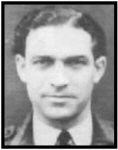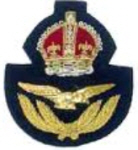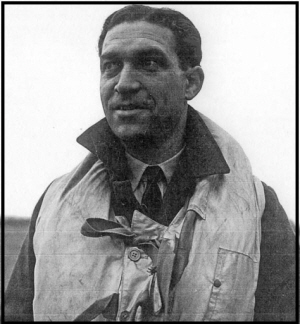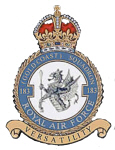







No.40166, Squadron Leader, Arthur Vincent GOWERS D.F.C.
Aged 30

|
Arthur Vincent Gowers was born on 18th June 1913 in Chelmsford (Chelmsford Q3-1913 4A:1336), son of Herbert Henry and Hilda Mary GOWERS (née BEDINGFIELD). In 1911 his father [24] a law clerk, mother [23] and brother Lawrence [7.5 months] were at 69 Baddow Road, Chelmsford, but by 1939 had moved to 14 Southcliff Park, Clacton on Sea with his cousin Olive [1902] He was at Chelmsford Grammar School and went on to work for Marconi. In 1932 he joined the Honourable Artillery Company but discharged himself to join the R.A.S.C (TA). He was commissioned in March 1943 but resigned in March 1936. He married Joan R CHURCH in 1939 (Newmarket Q2-1939 4A:2929). They had a daughter, Gloria H. |

|
Joining the RAFVR on July 5th 1937 to train as a pilot he applied for a short service commission and after some training was commissioned in October. He then went to No.5
flying Training School at RAF Sealand where he gained his wings in February 1938. Finishing the course he went to 26 Maintenance United, Cardington for flying duties,
joining 85 Squadron at Debden in August 1938. The squadron was sent to France when war broke out but he missed the withdrawal from Dunkirk as a result of a bout of jaundice
in April and sent back to England.
He rejoined 85 squadron when they were withdrawn to Debden. Around this time he moved to live in Steeple Bumpstead. In August 1940 they were at Debden again and on the 18th he claimed a "possible" Ju 97 over Canterbury. The day after, the squadron moved to Croydon and on the 28th he damaged a Me110, followed by a kill of a Me110 on the 30th and 2 Me109s on the 31st. On the 1st September in a dogfight with Me109s over Oxted he was forced to bail out with badly hurt hands and wounded hand and foot and admitted to N.C.C. Hospital at Caterham. When he rejoined 85 squadron in December they had converted to night patrols and he went in March 1941 to Watchfield for blind approach training. At the end of that tour he was awarded the Distinguished Flying Cross and attached to RAF Kenley for Control Room duties. On September 24th 1941 he was mentioned in despatches. On 21st October 1941 the attachment ended, and he was sent to 56 Operational Training United at RAF Sutton Bridge in November before going to 504 Squadron at Ballyherbert as a Flight Commander. His next posting was Air HQ Far East but the heat proved too much for his burnt hands and he was admitted to hospital in Delhi, before returning to UK in May . At Llandow he converted to Typhoons and then joined 56 Squadron at Snailwell on 8th August. As a Flight Lieutenant with 56 Squadron, Arthur survived a crash in Typhoon R7633 US-C on 27th August 1942 when his engine over-revved. He crash-landed in a field at Oulton in Norfolk, bounced over a hedge and across a road. The starboard wing of the Typhoon hit a tree on the way, the engine fell off and the smashed fighter finally stopped 50 yards further on-a write-off. Slightly injured, Arthur was taken to Norwich Hospital for treatment and two days later was transferred to the RAF Coltishall Sick Quarters. In "Wings for Victory Week" 1943 he took the salute at the March past in Chelmsford Next he went to Church Fenton on November 20th as Acting Squadron Leader in command of 183 Squadron flying Typhoons and led them on their first raid on 29th April 1943 against a power station at Yainville in France. The next "op" was escorting 486(New Zealand)Squadron when they bombed Triqueville airfield. The squadron then moved to Harrowbeer in Devon and then to Predannack near Mullion in Cornwall on 13th October. In the early evening of 24th October he led the attack in Cherbourg on the motor vessel 'Munsterland' believed to be carrying rare metals for the production of the V1 and V2. Heavy flack met them, on the alert following an earlier attack by Whirlwinds of 263 Squadron (escorted by Hurricanes of 257 Squadron), and Arthur was seen to go down in flames just outside the harbour. Two other aircraft were lost. Sources - The London Gazette of 1st July 1941, Issue 35206 - Supplement to The London Gazette of 23rd September 1941, Issue 35284, dated 24th September 1941 - The London Gazette of 25th November 1941, Issue 35358 His niece Sylvia Barnard published a book some 50 year later, putting together the life of "Gus" Gowers. "Never a dull moment" is now out of print though August 1943, on trials before delivery to 183 Squadron click here to go to the Commonwealth War Graves Commission website for full cemetery/memorial details |